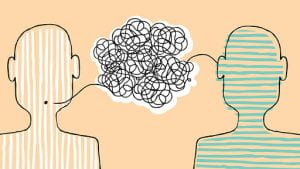Talking to a Brick Wall
Abstract
The feeling of talking to someone who isn’t listening to you is a sentiment that almost everyone has experienced. But the feeling of intentionally talking to someone when you know they aren’t going to understand is a little less common in everyday life. In healthcare, however, this problem is quite prevalent and often causes many issues. “Talking to a Brick Wall” is a series of narratives/journals exploring the importance of overcoming the language barrier to improve the interaction between healthcare professionals and their patients. The first narrative provides my perspective on how I now perceive the disparities resulting from language barrier conflicts between my grandfather and one of his doctors from years ago. The second journal-like entry explores my current interest in the presence of such a language barrier and exploring other’s perspectives, particularly from the viewpoint of the medical professional, with this issue in healthcare. The third narrative explores my prediction for the future with a potential solution on how to decrease the language barrier in healthcare to efficiently and accurately treat patients of different cultures and who speak different languages. Because language barriers can be responsible for reducing the satisfaction of medical providers and patients, as well as the quality of healthcare delivery and patient safety, it is very important to understand potential solutions for both parties involved. I believe that the audience for this piece can be anyone who is interested in the healthcare field or even who’s interested in the way language can foster or hinder relationships. I think language and understanding are often interpersonal skills that are taken for granted, so it is more important than ever to understand how to interact with people who don’t share a common language and what steps can be taken to accommodate for that difference.
ભુતકાળ (The Past)
The squeaks of shoes on the spotless white floor. The little puffs of breath as the pacing continued. The nervous fingernail biting and fidgeting in the seat next to me. Prayers and blessings muttered under my grandmother’s breath. I turn my head from looking at the walls to see all eyes trained on the door where my grandfather had just been wheeled through.
My dad whispers quickly into his phone, “Yes, he is with the doctor now. If all goes well, we should be talking about scheduling the procedure today.”
A few more moments pass in an eerie silence after my father hangs up. My father continues pacing, my brother continues fidgeting, and my grandmother continues praying, clutching her gold-plated statue of Lord Krishna in her hand and now clenching her eyes shut. I basically have the pictures’ frames on the wall memorized.
My dad walks over to his mother and places his hand on her shoulder and proceeds to close his eyes. They stay like that for a few minutes. My brother and I exchange glances more than a few times and his eyes scream for me to stay quiet and not utter a word. I comply.
The door hinge squeaks obnoxiously as it swings open and my grandfather is wheeled out by his doctor, who wears a hint of a subtle grin on his face. He wheels my grandfather up to us, and my father slowly walks towards them.
“How did it go?”, my father questions. The doctor smiles with alarmingly white teeth, “Everything went well. We should be able to schedule the surgery really soon.” He glances back towards my grandfather and asks, “Do you have any questions about the procedure?”
I knew my grandfather had questions about the procedure. A coronary artery bypass surgery is hard enough to say, but even more difficult to understand. He spent hours over the course of the last week talking to my dad and various family members around the world from Irvine to Ahmedabad, voicing his concerns and getting their two-cents. He had my brother find videos of the procedure on YouTube, so he could watch them, and even play some of them in 0.5x speed. I thought it was excessive, but it made sense. He’s an engineer through and through; he wants to know the mechanics of his body and the procedure.
But instead, he tilts his head to one side and gazes confusedly at the smiling doctor. He shrugs and faces my dad. My dad meets his eyes and proceeds to question the doctor about some of the nitty-gritty details of the procedure, questions that seem to be rehearsed and well thought about. Questions containing words like “angioplasty” and “restenosis.” I couldn’t keep up. My grandfather watches the Q and A carefully, mouth falling open and closing, as if a question or comment could just slip out at any moment. He doesn’t say anything else.
The ride back home is filled with a conversation I couldn’t keep up with. Words of Gujarati flowing rapidly out of my grandfather as he probes my dad for the doctor’s answers to his questions. My dad struggles to keep up, speaking in Guj-lish (Gujarati + English), trying to appease my grandfather’s demands for information about the procedure, racking his mind for the translation of words that he has never said in Gujarati before. This pattern continues, the whole ride home and what should be a thirty minute drive, turns into an entire lecture about the heart for my brother and I.
We finally reach home and my dad gets out of his seat quickly to help my grandfather out of the car. He takes the bulk of my grandfather’s weight as they walk towards the door and my grandfather pauses. He faces my dad and recites one of the only English phrases he doesn’t forget. “Thank you,” he says calmly. “But,” he starts in Gujarati, “maybe it would be easier if we see an Indian doctor next time.”
વર્તમાન (The Present)
“Hola Sra. Rodríguez. ¿Cómo está? ¿Puedes oírme y verme bien?”
Hello Mrs. Rodríguez. How are you? Can you hear and see me well?
“¿Cómo va el trabajo? ¿Algo demasiado estresante o algún cambio en su estilo de vida?”
How is work going? Anything too stressful or any changes to your lifestyle?
“Bien, la última vez que estuvo aquí…”
Okay, so the last time you were here…
These are the first few lines I uttered to my practice patient for my Spanish class this semester. We get the opportunity to practice our interpersonal conversation skills, so that we can be better prepared for working with Spanish-speaking patients in the future.
In the past, I always thought that the strength of the patient-doctor relationship weighed much more heavily on the doctors. I thought it was the doctor’s job to make the patients feel safe and cared for. I thought it was their job to make the patient trust them. But after trying to communicate with even a practice patient in a language that’s not my first language, I can understand why the language barrier places such a strain on the communication and relationship between a patient and their doctor.
Learning a language is one thing, but learning the subtle undertones of emotional intelligence for both a language and a culture is much more demanding and difficult, but the necessity for this enhanced emotional intelligence increases every day as patients’ experiences are affected negatively due to the barriers they encounter when interacting with their doctors.
After these revelations about the prevalent language barrier between patients and their medical professionals in TWO of my classes, I started to realize just how many people were affected by this issue and wanted to explore this topic a little more, especially from a physician’s perspective.
I think part of it is the psychological aspect. Why would you try to strengthen that relationship with your patient if you know that there is likely going to be a fundamental lack of understanding between you? This type of psychology discourages both the medical professional and the patient, so the overall impact is negative.
As a doctor, one of the foundations of the profession is being able to help people to the best of your ability. It is one of the pillars of the ‘Hippocratic oath’ and what doctors abide by. But if the doctors fail to understand the complex nature of a patients’ background, culture, or problem, then their “best” probably isn’t sufficient to meet the needs of the patient and the cycle of negative health outcomes proceeds.
How is it that I never saw this disparity before? I grew up in a house where my grandparents only knew and spoke Gujarati and yet, always assumed that their lives were completely unaffected by the fact that they lived in a country where they didn’t understand the primary language. So, how do I want to fix this in the future or how do I want to be a better doctor for patients that might not speak English?
ભવિષ્યમાં (The Future)
“Dr. Shah, your patient’s here in Room 5 whenever you’re ready,” the nurse says to me with a smile. I quickly glance through the manila file folder placed in front of me and the highlighted word FRENCH in all caps stands out on the personal information form.
French, I haven’t had to work with an interpreter who speaks French yet. This should be interesting, I thought to myself.
It was just a few months ago that the hospital had finally taken the doctors’ feedback and hired an incredible staff of interpreters and an increasing number of bilingual doctors and nurses to be able to reach the most patients and provide them with the best quality of care.
We had previously tried to allow family members to translate on their patient’s behalf, but several problems quickly arose as family members often lacked the appropriate language skills and knowledge of medical terminology. The communication showed to compromise patient-doctor confidentiality, censor important information, and impact family dynamics, overall.
I remember when a young girl came in translating for her mother, however her mother was hesitant to provide any details about her personal life because she didn’t want to make her daughter translate that.
Hence, there was a need for a new solution to effectively work with patients who spoke different languages and have a specific cultural identity.
We had heard about Stratus Video through the doctors’ grapevine as other hospitals were slowly acclimating to the use of their technology to provide interpreter services to their patients. There are 200 languages available for translation, plus video interpreting services for 37 languages, including American Sign Language.
From practice, an iPad could be used for translation services, but the video interpreter option is much more helpful for patients to choose, and more effective, because the interpreter is able to read the nonverbal cues of the patient much more effectively than a simple translating service.
Walking excitedly at the idea of getting to work with a new interpreter, I quickly reach the patient’s room and knock, allowing them a few seconds of time to prepare themselves. “Hello! How are you doing today?, I ask”. A voice comes from the monitor placed across from me. “Elle a dit ‘Bonjour! Comment ça va aujourd’hui?’ ”, the interpreter says. The patient smiles at me and I smile back, guilt-free and happy to be finally understood.
References
Fadiman, Anne. The Spirit Catches You and You Fall Down: A Hmong Child, Her American Doctors, and the Collision of Two Cultures. New York: Farrar, Straus, and Giroux, 1997.
Steinberg, Emma M, Doris Valenzuela-Araujo, Joseph S Zickafoose, Edith Kieffer, and Lisa Ross DeCamp. “The ‘Battle’ of Managing Language Barriers in Health Care.” Clinical pediatrics. U.S. National Library of Medicine, December 2016.
Al Shamsi, Hilal, Abdullah G Almutairi, Sulaiman Al Mashrafi, and Talib Al Kalbani. “Implications of Language Barriers for Healthcare: A Systematic Review.” Oman medical journal. OMJ, April 30, 2020.
Partida, Yolanda. “Language Barriers and the Patient Encounter.” Journal of Ethics | American Medical Association. American Medical Association, August 1, 2007.
Ali, Parveen Azam, and Roger Watson. “Language Barriers and Their Impact on Provision of Care to Patients with Limited English Proficiency: Nurses’ Perspectives.” Wiley Online Library. John Wiley & Sons, Ltd, March 25, 2018.

